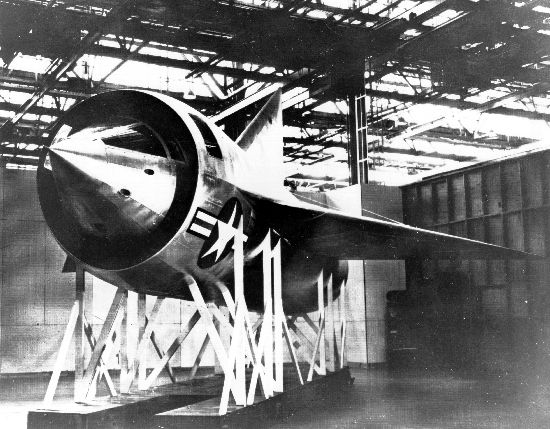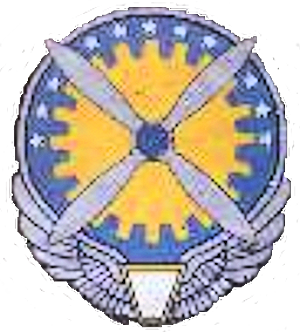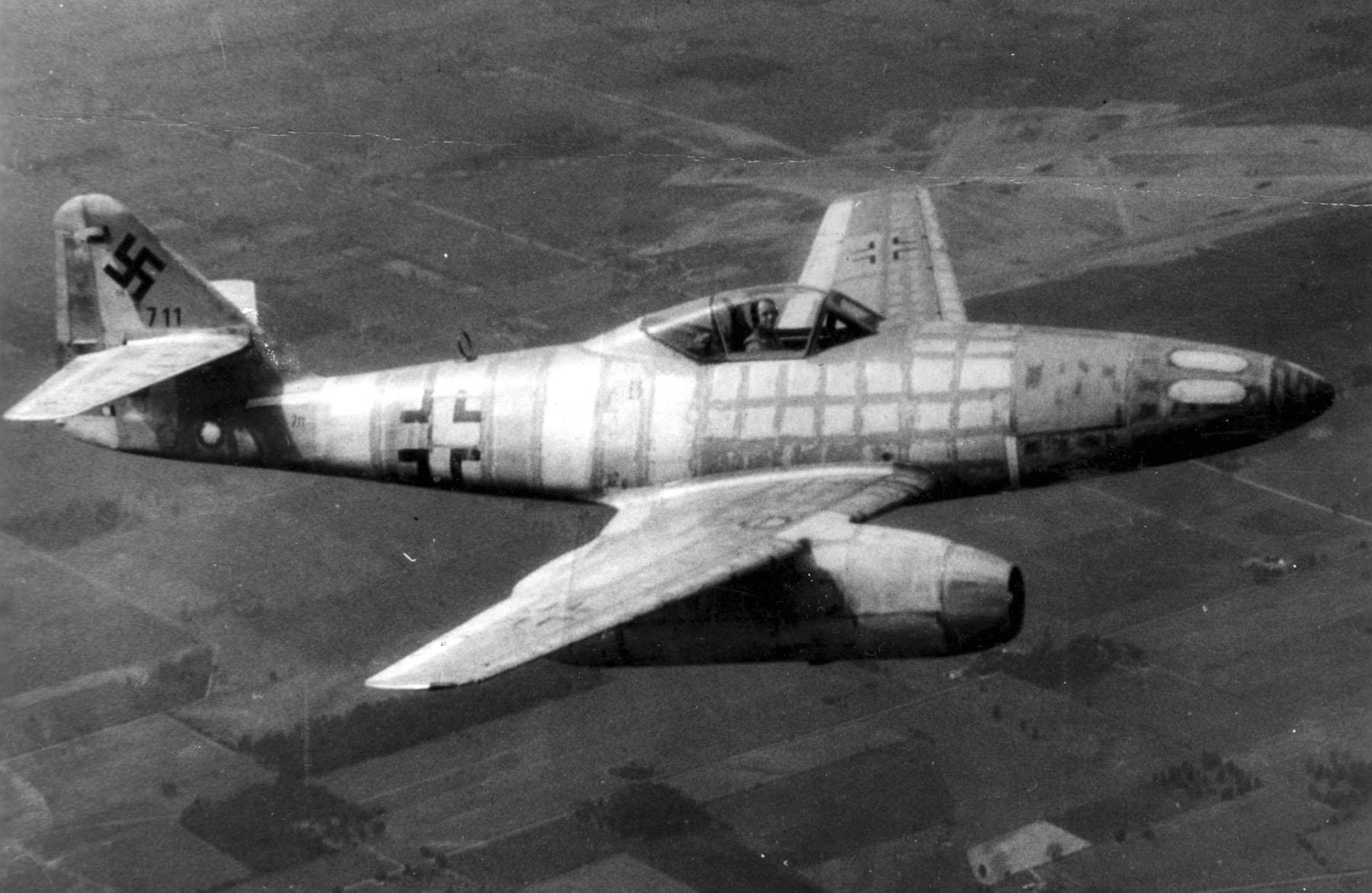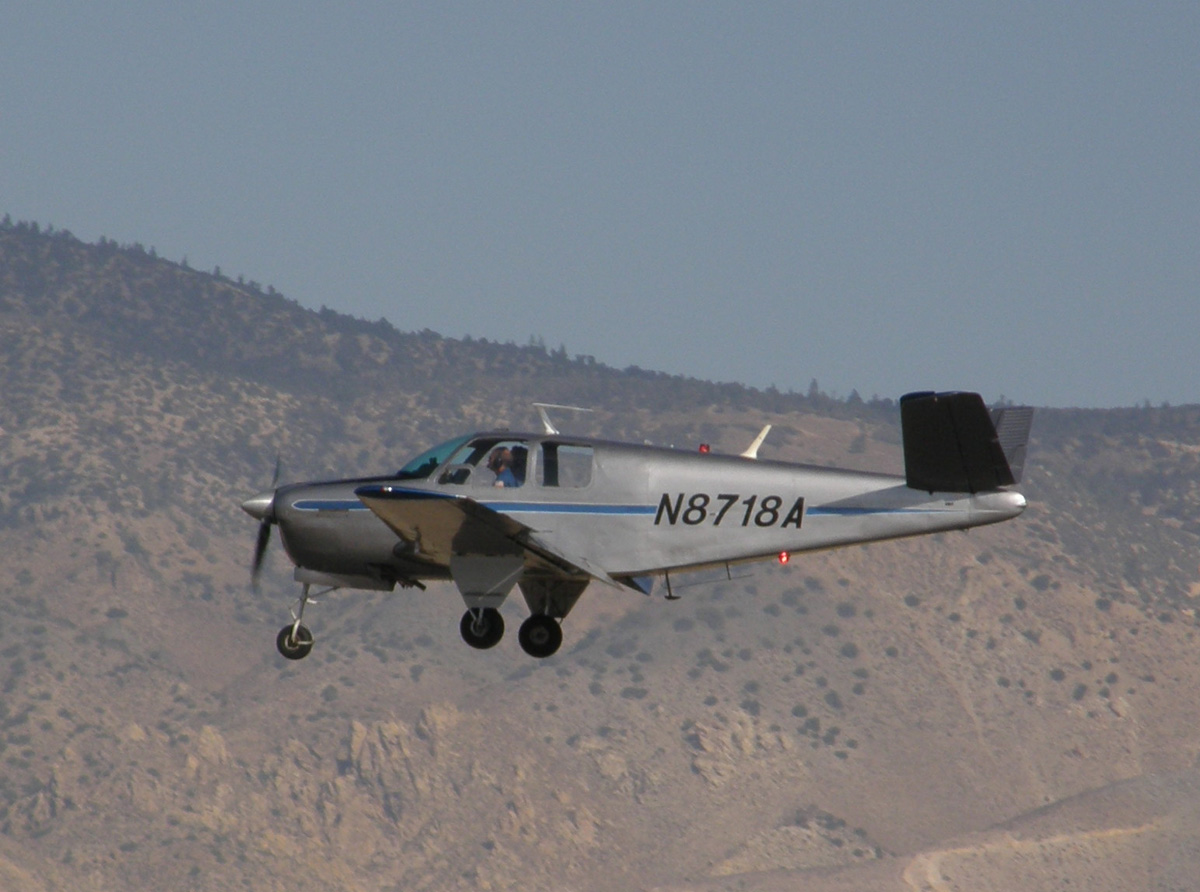|
Convair XF-92
The Convair XF-92 (re-designated from XP-92 in 1948) was an American, delta wing, first-generation jet prototype. Originally conceived as a point-defence interceptor, the design was later used purely for experimental purposes and only one was built. However, it led Convair to use the delta-wing on a number of designs, including the F-102 Delta Dagger, F-106 Delta Dart, B-58 Hustler, the US Navy's F2Y Sea Dart as well as the VTOL FY Pogo. Design and development Early work Prior to August 1945, the Vultee Division of Consolidated-Vultee looked at the possibility of a swept-wing aircraft powered by a ducted rocket. Years earlier, the company had performed designs which involved liquid-cooled radiator engines. With this design, fuel would be added to the heat produced by small rocket engines in the duct, creating a "pseudo-ramjet".Jenkins and Landis 2008, p. 122. In August 1945, the United States Army Air Forces (USAAF), soon to be renamed the United States Air Force, ... [...More Info...] [...Related Items...] OR: [Wikipedia] [Google] [Baidu] |
WikiProject Aircraft
A WikiProject, or Wikiproject, is a Wikimedia movement affinity group for contributors with shared goals. WikiProjects are prevalent within the largest wiki, Wikipedia, and exist to varying degrees within Wikimedia project, sister projects such as Wiktionary, Wikiquote, Wikidata, and Wikisource. They also exist in different languages, and translation of articles is a form of their collaboration. During the COVID-19 pandemic, CBS News noted the role of Wikipedia's WikiProject Medicine in maintaining the accuracy of articles related to the disease. Another WikiProject that has drawn attention is WikiProject Women Scientists, which was profiled by ''Smithsonian Magazine, Smithsonian'' for its efforts to improve coverage of women scientists which the profile noted had "helped increase the number of female scientists on Wikipedia from around 1,600 to over 5,000". On Wikipedia Some Wikipedia WikiProjects are substantial enough to engage in cooperative activities with outside organization ... [...More Info...] [...Related Items...] OR: [Wikipedia] [Google] [Baidu] |
VTOL
A vertical take-off and landing (VTOL) aircraft is one that can take off and land vertically without relying on a runway. This classification can include a variety of types of aircraft including helicopters as well as thrust-vectoring fixed-wing aircraft and other hybrid aircraft with powered rotors such as cyclogyros/cyclocopters and gyrodynes. Some VTOL aircraft can operate in other modes as well, such as CTOL (conventional take-off & landing), STOL (short take-off & landing), or STOVL (short take-off & vertical landing). Others, such as some helicopters, can only operate as VTOL, due to the aircraft lacking landing gear that can handle taxiing. VTOL is a subset of V/STOL (vertical or short take-off & landing). Some lighter-than-air aircraft also qualify as VTOL aircraft, as they can hover, takeoff and land with vertical approach/departure profiles. Electric vertical takeoff and landing aircraft, or eVTOLs, are being developed along with more autonomous flight con ... [...More Info...] [...Related Items...] OR: [Wikipedia] [Google] [Baidu] |
Wright-Patterson Air Force Base
Wright-Patterson Air Force Base (WPAFB) is a United States Air Force base and census-designated place just east of Dayton, Ohio, in Greene and Montgomery counties. It includes both Wright and Patterson Fields, which were originally Wilbur Wright Field and Fairfield Aviation General Supply Depot. Patterson Field is approximately northeast of Dayton; Wright Field is approximately northeast of Dayton. The host unit at Wright-Patterson AFB is the 88th Air Base Wing (88 ABW), assigned to the Air Force Life Cycle Management Center and Air Force Materiel Command. The 88 ABW operates the airfield, maintains all infrastructure and provides security, communications, medical, legal, personnel, contracting, finance, transportation, air traffic control, weather forecasting, public affairs, recreation and chaplain services for more than 60 associate units. The base's origins begin with the establishment of Wilbur Wright Field on 22 May and McCook Field in November 1917, both establis ... [...More Info...] [...Related Items...] OR: [Wikipedia] [Google] [Baidu] |
Alexander Lippisch
Alexander Martin Lippisch (November 2, 1894 – February 11, 1976) was a German aeronautical engineer, a pioneer of aerodynamics who made important contributions to the understanding of tailless aircraft, delta wings and the ground effect, and also worked in the U.S. Within the Opel-RAK program, he was the designer of the world's first rocket-powered glider. He developed and conceptualized delta wing designs which functioned practically in supersonic delta wing fighter aircraft as well as in hang gliders. People he worked with continued the development of the delta wing and supersonic flight concepts over the 20th century. His most famous designs are the Messerschmitt Me 163 rocket-powered interceptorReitsch, H., 1955, The Sky My Kingdom, London: Biddles Limited, Guildford and King's Lynn, and the Dornier Aerodyne. Early life Lippisch was born in Munich, Kingdom of Bavaria. He later recalled that his interest in aviation began with a demonstration conducted by Orvill ... [...More Info...] [...Related Items...] OR: [Wikipedia] [Google] [Baidu] |
Wind Tunnel
Wind tunnels are large tubes with air blowing through them which are used to replicate the interaction between air and an object flying through the air or moving along the ground. Researchers use wind tunnels to learn more about how an aircraft will fly. NASA uses wind tunnels to test scale models of aircraft and spacecraft. Some wind tunnels are large enough to contain full-size versions of vehicles. The wind tunnel moves air around an object, making it seem as if the object is flying. Most of the time, large powerful fans suck air through the tube. The object being tested is held securely inside the tunnel so that it remains stationary. The object can be an aerodynamic test object such as a cylinder or an airfoil, an individual component, a small model of the vehicle, or a full-sized vehicle. The air moving around the stationary object shows what would happen if the object was moving through the air. The motion of the air can be studied in different ways; smoke or dye can be ... [...More Info...] [...Related Items...] OR: [Wikipedia] [Google] [Baidu] |
Air Materiel Command
Air Materiel Command (AMC) was a United States Army Air Forces and United States Air Force command. Its headquarters was located at Wright-Patterson Air Force Base, Ohio. In 1961, the command was redesignated the Air Force Logistics Command with some of its functions transferred to the new Air Force Systems Command. History The logistics function can be traced before the earliest days of the Air Service, when the Equipment Division of the U.S. Army Signal Corps established a headquarters for its new Airplane Engineering Department at McCook Field, Dayton, Ohio. Airplane Engineering Department The Airplane Engineering Department was established by the Equipment Division of the U.S. Army Signal Corps in 1917 for World War I experimental engineering. The department had a 1917 Foreign Data Section, and the Airplane Engineering Department was on McCook Field at Dayton, Ohio. McCook Field established the Air School of Application in 1919 and after WW I, the department was ... [...More Info...] [...Related Items...] OR: [Wikipedia] [Google] [Baidu] |
Swept Wing
A swept wing is a wing that angles either backward or occasionally Forward-swept wing, forward from its root rather than in a straight sideways direction. Swept wings have been flown since the pioneer days of aviation. Wing sweep at high speeds was first investigated in Germany as early as 1935 by Albert Betz and Adolph Busemann, finding application just before the end of the Second World War. It has the effect of delaying the shock waves and accompanying aerodynamic drag rise caused by fluid compressibility near the speed of sound, improving performance. Swept wings are therefore almost always used on jet aircraft designed to fly at these speeds. The term "swept wing" is normally used to mean "swept back", but variants include forward-swept wing, forward sweep, Variable-sweep wing, variable sweep wings and oblique wings in which one side sweeps forward and the other back. The delta wing is also aerodynamically a form of swept wing. Reasons for sweep There are three main reasons ... [...More Info...] [...Related Items...] OR: [Wikipedia] [Google] [Baidu] |
Consolidated Vultee
Convair, previously Consolidated Vultee, was an American aircraft manufacturing company that later expanded into rockets and spacecraft. The company was formed in 1943 by the merger of Consolidated Aircraft and Vultee Aircraft. In 1953, it was purchased by General Dynamics, and operated as their Convair Division for most of its corporate history. Convair is best known for its military aircraft; it produced aircraft such as the Convair B-36 Peacemaker and Convair B-58 Hustler strategic bombers, and the Convair F-102 Delta Dagger and Convair F-106 Delta Dart interceptors. It also manufactured the first Atlas rockets, including the rockets that were used for the crewed orbital flights of Project Mercury. The company's subsequent Atlas-Centaur design continued this success and derivatives of the design remain in use as of 2020. The company also entered the jet airliner business with its Convair 880 and Convair 990 designs. These were smaller than contemporary aircraft lik ... [...More Info...] [...Related Items...] OR: [Wikipedia] [Google] [Baidu] |
V-tail
The V-tail or ''Vee-tail'' (sometimes called a butterfly tail or Rudlicki's V-tailGudmundsson S. (2013). "General Aviation Aircraft Design: Applied Methods and Procedures" (Reprint). Butterworth-Heinemann. p. 489. , 9780123973290) of an aircraft is an unconventional arrangement of the tail control surfaces that replaces the traditional fin and horizontal surfaces with two surfaces set in a V-shaped configuration. It is not widely used in aircraft design. The aft edge of each twin surface is a hinged control surface called a ruddervator, which combines the functions of both a rudder and elevator. The V-tail was invented in 1930 by Polish engineer Jerzy Rudlicki and was tested for the first time on the Hanriot H-28 trainer aircraft, modified by a Polish aerospace manufacturer Plage and Laśkiewicz in the summer of 1931. Variants The X-shaped tail surfaces of the experimental Lockheed XFV were essentially a V tail that extended both above and below the fuselage. Conventional ... [...More Info...] [...Related Items...] OR: [Wikipedia] [Google] [Baidu] |
United States Army Air Forces
The United States Army Air Forces (USAAF or AAF) was the major land-based aerial warfare service component of the United States Army and ''de facto'' aerial warfare service branch of the United States during and immediately after World War II (1941–1945). It was created on 20 June 1941 as successor to the previous United States Army Air Corps and is the direct predecessor of the United States Air Force, today one of the six armed forces of the United States. The AAF was a component of the United States Army, which on 2 March 1942 was divided functionally by executive order into three autonomous forces: the Army Ground Forces, the United States Army Services of Supply (which in 1943 became the Army Service Forces), and the Army Air Forces. Each of these forces had a commanding general who reported directly to the Army Chief of Staff. The AAF administered all parts of military aviation formerly distributed among the Air Corps, General Headquarters Air Force, and the gro ... [...More Info...] [...Related Items...] OR: [Wikipedia] [Google] [Baidu] |
Ramjet
A ramjet, or athodyd (aero thermodynamic duct), is a form of airbreathing jet engine that uses the forward motion of the engine to produce thrust. Since it produces no thrust when stationary (no ram air) ramjet-powered vehicles require an assisted take-off like a rocket assist to accelerate it to a speed where it begins to produce thrust. Ramjets work most efficiently at supersonic speeds around and can operate up to speeds of . Ramjets can be particularly useful in applications requiring a small and simple mechanism for high-speed use, such as missiles. The US, Canada, and UK had widespread ramjet powered missile defenses during the 1960s onward, such as the CIM-10 Bomarc and Bloodhound. Weapon designers are looking to use ramjet technology in artillery shells to give added range; a 120 mm mortar shell, if assisted by a ramjet, is thought to be able to attain a range of . They have also been used successfully, though not efficiently, as tip jets on the ends of hel ... [...More Info...] [...Related Items...] OR: [Wikipedia] [Google] [Baidu] |








